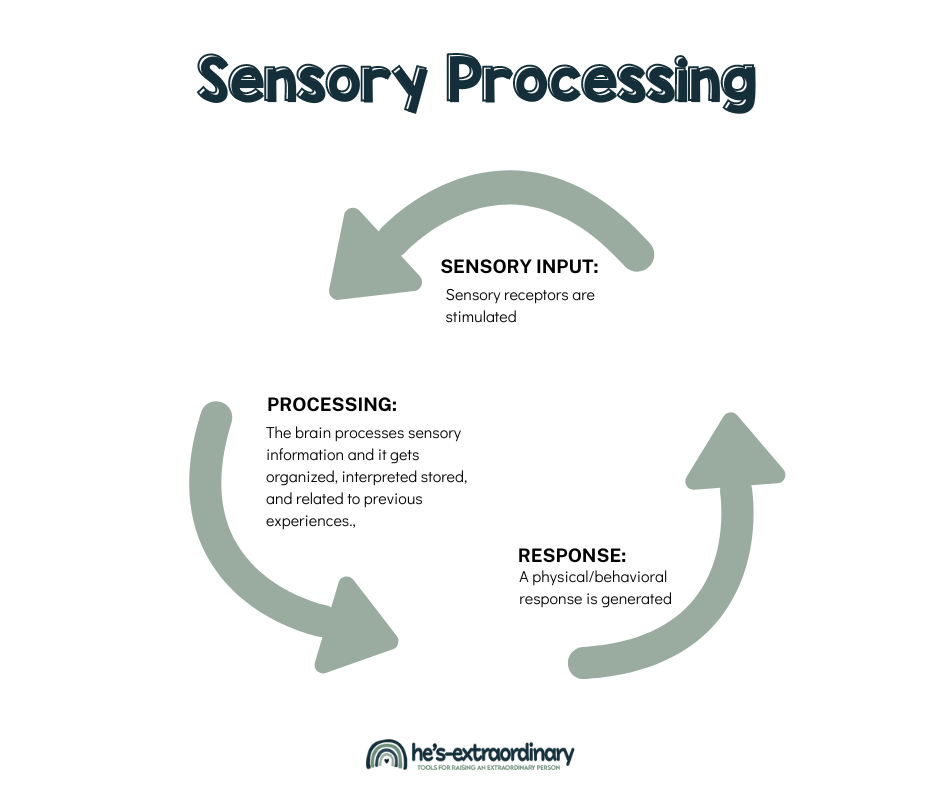Sensory Integration and Learning: Overcoming Challenges in the Classroom
What’s inside this article: An overview of what sensory integration is, how sensory integration challenges impact academic success, and strategies for supporting sensory integration in schools.
What is Sensory Integration?
Sensory integration is a crucial process that constantly happens inside our bodies without our awareness. It’s how our brains receive, interpret, and organize sensory information from our environment and our bodies to produce appropriate responses.
This process allows us to understand and interact with the world effectively.
Key Components of Sensory Integration
The process involves our brain receiving sensory input, processing that input into one coherent message, and then generating a situationally appropriate behavioral response.
The whole process, described below, happens autonomically.
Sensory Reception:
- Sensory Receptors: We have sensory receptors throughout our bodies. They’re in our eyes, ears, skin, muscles, and other sensory organs; these receptors detect stimuli such as light, sound, touch, movement, and body position.
- Sensory Modalities: The primary sensory modalities include visual (sight), auditory (hearing), tactile (touch), olfactory (smell), gustatory (taste), vestibular (balance and movement), and proprioceptive (body position and muscle movement).
Sensory Processing:
- Detection and Transmission: The sensory receptors detect stimuli and send this information through the nervous system to the brain.
- Interpretation: The brain interprets and organizes the sensory information, filtering out irrelevant stimuli and focusing on what is important.
- Integration: The brain integrates all the information from different sensory modalities to form one coherent picture of the environment. This integration helps us understand and react appropriately to our surroundings.
Motor Response and Behavioral Output:
- Response Planning: The brain plans an appropriate motor response based on the integrated sensory information. For example, if you touch a hot surface, you’ll quickly jerk your hand away. This happens because the brain rapidly processes the pain signal and triggers a withdrawal response.
- Execution: The planned response is executed through the motor system, resulting in actions such as moving, speaking, or adjusting posture.

Importance of Sensory Integration
Sensory integration is essential for daily functioning and learning. It helps us:
- Coordinate Movements: Proper sensory integration allows us to perform complex motor tasks such as writing, bike riding, or playing sports.
- Maintain Attention: Filtering out irrelevant sensory input helps us focus on tasks and maintain attention.
- Regulate Emotions: Effective sensory processing contributes to emotional regulation and stress management.
- Develop Social Skills: Appropriately interpreting social cues relies on well-integrated sensory processing.
Sensory Integration Dysfunction
When sensory integration does not occur efficiently, it leads to sensory processing disorders (SPD). Approximately 1 in 6 children experience some degree of sensory processing challenges, and over 95% of children with autism also have difficulties related to sensory integration.
Someone with sensory challenges may over-respond or under-respond to sensory stimuli, affecting their ability to function in daily life.
These challenges can lead to:
- Hypersensitivity: Overreaction to sensory input, such as being overwhelmed by loud noises or bright lights.
- Hyposensitivity: Underreaction to sensory input, such as not noticing pain or needing intense stimuli to respond.
- Sensory Seeking: Craving sensory experiences, such as constantly touching objects or seeking movement.
- Sensory Avoiding: Avoiding sensory experiences, such as refusal to wear certain fabrics or avoiding playground equipment.
How Sensory Integration Challenges Impact Academic Success
Attention and Focus
Sensory integration challenges can significantly affect a child’s ability to concentrate in the classroom.
Students with sensory sensitivities may be easily distracted by sounds, lights, or movements that others don’t even notice. This means they are constantly distracted in class, leading to difficulties paying attention during instruction time and trouble focusing on completing work.
In turn, they may struggle to retain new information, take longer to complete assignments or produce lower-quality work.
Task Completion and Academic Performance
Sensory processing difficulties can also interfere with a student’s ability to complete tasks efficiently.
Sensory overload or seeking behaviors can result in procrastination, incomplete assignments, or a general decline in academic performance, as they impact executive functioning.
For instance, if a child is constantly seeking sensory input, they may have difficulty sitting still long enough to complete homework or classwork.
Behavioral Issues
Students with sensory integration challenges often display behavioral issues in response to sensory overload or unmet sensory needs.
Additionally, the adults around them often misunderstand these behaviors, believing they choose to act up for attention or because they don’t want to do the schoolwork.
These behaviors can include hyperactivity, withdrawal, behavioral outbursts, and meltdowns. This not only disrupts their own learning but also that of their peers.
For example, a child with tactile defensiveness might react aggressively if a peer unexpectedly touches them.
Social Interactions
Sensory processing challenges also hinder students’ ability to engage in positive social interactions.
Difficulties interpreting social cues or maintaining appropriate personal space can make it difficult for these students to form and maintain friendships.
Sensory challenges can also lead to social isolation. For example, a child hypersensitive to sound might avoid group activities or playground interactions due to the noise level, limiting their opportunities for social engagement.
Emotional Regulation
Effective sensory integration is crucial for emotional regulation. Students with sensory processing difficulties may experience heightened emotional responses to sensory stimuli, leading to increased stress and anxiety.
Sensory overload can also trigger emotional outbursts or meltdowns, which are distressing for the student and disruptive in a classroom setting. For example, a child with low registration might become overwhelmed by sudden changes in routine, leading to a meltdown or shutdown.

Strategies for Supporting Sensory Integration in Schools
Sensory-Friendly Classrooms
Creating sensory-friendly classroom environments can help mitigate the impact of sensory processing challenges. This includes reducing sensory distractions and providing sensory tools and accommodations.
Find a detailed guide to creating a sensory-friendly classroom here.
Classroom Accommodations
In addition to creating a sensory-friendly classroom, providing additional classroom accommodations can help meet the individual needs of children struggling with sensory integration.
For example, make noise-canceling headphones avoidable to hypersensitive students to help them filter out distractions and offer fidget toys or alternative seating options for sensory seekers who frequently fidget.
Read: 50+ Student Accommodations to Help Kids Succeed at School
Sensory Breaks
Incorporating regular sensory breaks into the school day can help students with sensory processing challenges to reset and refocus.
Sensory breaks are short, scheduled breaks that include physical activities like stretching, jumping, or swinging and help meet student’s sensory needs.
Individualized Sensory Diets
A sensory diet is a carefully designed set of sensory activities created by an occupational therapist to support an individual’s sensory needs and help with sensory processing challenges.
Activities can range from heavy work (pushing or pulling tasks) to fine motor activities (beading or drawing) and are designed to provide the appropriate sensory input needed to help the student stay regulated and focused.
Read: 200+ Sensory Diet Activities
Collaborative Approach
Parents, teachers, occupational therapists, and other sensory and developmental experts need to work together to successfully develop and implement the right sensory integration strategies to support children’s individual needs.
Regular communication and collaboration among educators, therapists, and families can help identify effective strategies and ensure consistency across different settings (home and school).
Benefits of Using Sensory Integration Strategies at School
Effective sensory integration strategies can help kids become more successful at school by:
- Improving Focus and Attention: These strategies help students regulate their responses to sensory stimuli, allowing them to concentrate better in class.
- Enhancing Emotional Regulation: Students have less anxiety and can better regulate their emotions when they are sensorily balanced.
- Improving Academic Performance: With better focus and emotional regulation, students can engage more effectively in learning activities.
- Promoting Social Skills: Improved sensory processing helps students interact more positively with peers and teachers.
Remember, sensory integration is crucial in helping children succeed academically.
By understanding sensory processing and implementing tailored sensory integration strategies, educators can create supportive environments that enhance learning, improve behavior, and increase social skills.
Schools that embrace sensory-friendly practices not only help students with sensory challenges but also create a more inclusive and effective learning environment for all.

